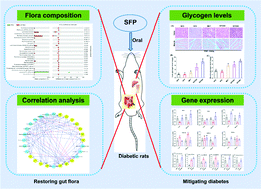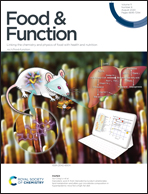Antidiabetic effects and underlying mechanisms of anti-digestive dietary polysaccharides from Sargassum fusiforme in rats
Abstract
Sargassum fusiforme polysaccharides (SFP), an anti-digestive biologically active ingredient obtained from Sargassum fusiforme by ultrasound-assisted enzymatic extraction, have been proven to exhibit extremely strong alpha-glucosidase inhibitory activity. In the current research, the potential anti-diabetic effects and molecular mechanisms of SFP were investigated by classic biochemical analysis, high-throughput sequencing and molecular biology techniques in type 2 diabetic rats. The analysis of typical diabetic symptoms and serum profiles showed that oral administration of SFP could mitigate hyperglycemia, hyperinsulinemia, dyslipidemia and oxidative stress in diabetic rats. SFP also promoted glycogen synthesis in the liver and skeletal muscles. H&E staining observation confirmed that SFP intervention could partially repair liver and muscle injuries caused by diabetes. Moreover, 16S rRNA gene sequencing analysis indicated that SFP treatment could distinctly restore the beneficial composition of gut flora in diabetic rats. Furthermore, RT-qPCR analysis revealed that anti-diabetic effects of SFP may be closely related to accelerating the absorption and utilization of blood glucose in the liver and muscle and inhibiting hepatic glucose production. In short, this study demonstrated that SFP could be developed as functional foods or pharmaceutical supplements for the prevention or mitigation of diabetes and its complications.



 Please wait while we load your content...
Please wait while we load your content...